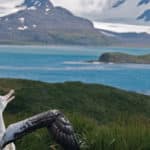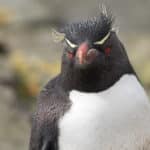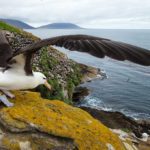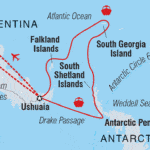Crossing the Antarctic Circle via Falklands & South Georgia from Buenos Aires
Become well acquainted with Antarctica's icy wilderness on this crossing of the Antarctic Circle that stops by the Falklands and South Georgia. Cruise across oceans bubbling with sealife, step foot on islands that few people get to walk on and witness massive glaciers and sparkling ice sheets glistening in the ocean. Learn about the local fauna from experts during onboard presentations, grasp the sheer magnitude of Shackleton's survival in South Georgia and wander among thousands of penguins in the Falklands. At 23 days in length, this crossing of the Antarctic Circle will endow a deep appreciation of this astounding region.
23 days, from
$85,790
per person
GROUP SIZE
ACTIVITY LEVEL
Details
Countries Visited:
Antarctica
Argentina
Falkland Islands (malvinas)
South Georgia
Accommodation:
Transportation: Ship , zodiac , plane
Included Meals:
- 22 breakfasts
- 21 dinners
Group size: Minimum 1, Max 200
Minimum Age:
Contrast the sophisticated Argentinian capital of Buenos Aires with the Patagonian outpost of Ushuaia - two totally different locations
South Georgia Island is incredibly rich in rare wildlife and history. See over 30 species of birds, including four penguin species, and visit the grave of the great explorer, Sir Ernest Shackleton
Encounter whales, seals and penguins on regular Zodiac excursions along the plunging coastline of the Antarctic Peninsula
On-board lectures by polar experts provide great insight into the unique history, geology and wildlife of the region
Few people ever get the opportunity to set foot on the Great White Continent, but you'll be one of them
A diversity of possible landing sites and activities allows you to see the spectacular Antarctic Peninsula from multiple perspectives
Optional activities such as sea kayaking or polar ice camping on selected voyages can take your adventure to the next level. Book early, as these sell out fast
Itinerary
Welcome to Buenos Aires, where your Antarctic adventure begins. Arrive into the city at any time today, and independently transfer to the group hotel (accommodation is included for the night). After checking in, meet your fellow travellers and be briefed by the expedition team about the journey ahead. If you arrive early into Buenos Aires, there’s plenty to see and do. Perhaps explore the neighbourhood of La Boca, pay your respects to Eva Peron at the famous Recoleta Cemetery or search through the antique markets of San Telmo.
After breakfast at the hotel, the group will transfer to the airport and board a private charter flight to Ushuaia. On arrival, enjoy free time exploring this Patagonian port town at the ‘end-of-the-world’. In the late afternoon set sail through the historic Beagle Channel, which transects the Tierra del Fuego archipelago and opens up into the Southern Ocean. Photo opportunities abound, as dramatic coastlines emerge and seabirds sore overhead.
There are many activities to keep you engaged while at sea. Take advantage of the library of books available on the ship, become acquainted with fellow travellers at the bar and enjoy spectacular views from the deck. Thick parkas will be provided to keep you warm. The expedition team will conduct a series of presentations to prepare you for the Zodiac cruises and shore landings ahead.
Explore the two main islands, East and West, of the rugged Falkland archipelago on Zodiac excursions and daily landings. Visit the capital of Stanley, a remote and peaceful outpost with a British country charm. There are plenty of churches and museums to explore, and the locals are often happy to chat over a drink at the pub. Wildlife sightings around the Falkland Islands should include at least three species of penguin and two endemic bird species - Cobb’s wren and the flightless steamer duck. The expedition team will educate you on the local flora and fauna so you will know what you’re looking for.
POSSIBLE LANDING SITES AND WILDLIFE SIGHTINGS - FALKLAND ISLANDS
CARCASS ISLAND
The 8 km long (five mile) island, northwest of West Falkland, belongs to Rob and Lorraine McGill. It's a picturesque island, where songbirds nest among the luxuriant growth that covers the gently rolling landscape. The island is named after a Royal Navy ship, the HMS Carcass, which arrived in 1766.
NEW ISLAND
The most southwesterly island in the archipelago is about 13 km (eight miles) long and 800 m wide. The western side of the island is a cliff 183 m high, while the eastern side slopes to the sea. Tony Chater and Ian Strange hold ownership of the island, and have turned their respective portions into nature reserves.
STANLEY
The deep-water harbour of Stanley was the economic mainstay of the Falkland area in the 19th century. Sailing ships damaged while rounding Cape Horn called in for expensive repairs, and vessels carrying fortune seekers on their way to the gold fields of California and Australia often docked at Stanley as well. Stanley is as lively as it gets in the Falklands, and the future of the port may be bright if hydrocarbon deposits off the coast prove to be abundant.
WEST POINT ISLAND
The Napier family has owned this island since the 1860s. Black-browed albatross and rockhopper penguins nest on cliffs along the water’s edge, and Commerson’s dolphins are often seen in the water surrounding the island.
The following Optional Activities are available to participate in, on some or all of the departures of this itinerary. These must be booked in advance (additional costs apply) and space is limited.
KAYAKING – Our kayaking adventures are the best way to feel at one with the sea. Taken in small groups of maximum 16 people, multiple times per voyage, kayaking adventures are only conducted during calm weather conditions. Kayaking is open to all levels of experience, however kayaking in the polar waters is not suitable for novice kayakers. Beginners interested in kayaking should first take an introductory course prior to the voyage which includes how to do a wet exit. In addition regardless of your experience, we recommend you take part in some kayaking practise prior to the voyage to ensure that you are comfortable on the water in the icy conditions.
STAND-UP PADDLEBOARDING - Combining surfing with kayaking or canoeing, stand-up paddleboarding will give you a very personal and unique perspective on Antarctica. This activity is taken in small groups in good weather conditions on calm bays and harbours, with a Zodiac following for your safety.
INCLUDED OPTIONAL ACTIVITIES
PHOTOGRAPHY - Antarctica is one of the most abundantly photogenic destinations in the world. Penguins amble across pebbled beaches, whales spy-hop from the crystal blue sea and sparkling icebergs tower in this serene, yet dramatic environment. Whether you own a serious SLR or a simple point-and-shoot, our on-board photography expert provides you with hands-on instruction and technical tips to ensure that you capture the best of your Antarctica experience.
En route to South Georgia Island, cross the invisible biological boundary of the Antarctic Convergence. Unique to Antarctica, this meeting of oceans creates an abundance of krill and marine life. With the help of the expedition team, keep an eye out for large cetaceans, including humpback whales.
South Georgia is sometimes referred to as the ‘Galapagos of the Poles’ due to the diversity and abundance of its wildlife. Visit rookeries teeming with hundreds of thousands of king and macaroni penguins. Encounter huge elephant seals or smaller fur seals, as well as shags, prions and albatrosses. You’ll also have the chance to see the grave of the great explorer, Sir Ernest Shackleton, at the settlement of Grytviken. Excursions are determined by weather conditions, but your expedition team will ensure that each landing offers something unique.
POSSIBLE LANDINGS AND WILDLIFE SIGHTINGS – SOUTH GEORGIA
DRYGALSKI FJORD
This is a photogenic and dramatic fjord, with sharp and jagged peaks rising out of the sea. Glaciation never reached the peaks of this fjord, giving it a unique landscape.
GOLD HARBOUR
The backdrop to this harbour is the hanging Bertrab Glacier. King and gentoo penguins call this place home, as do rowdy elephant and fur seals.
GRYTVIKEN
Only a handful of people live on South Georgia, a United Kingdom overseas territory. Two of them are curators of the South Georgia Museum, located in the former whaling station manager’s villa. A church was built for the whaling community and is the only building in Grytviken that is still used for its original purpose.
PRION ISLAND
Robert Cushman Murphy named this island for the species of petrels seen here. Wandering albatross are also known to nest on the island.
SALISBURY PLAIN
One of the largest king penguin rookeries in South Georgia is located on Salisbury Plain. The Murphy and Lucas Glaciers flank the plain, creating a perfect backdrop for photographers.
ST. ANDREW'S BAY
Thousands of breeding pairs of king penguins nest at St. Andrew’s Bay. It is the largest king penguin rookery on South Georgia and quite a spectacle to behold. Reindeer introduced by Norwegian whalers are known to feed on the grass in the area.
STROMNESS
This abandoned whaling station was in full operation the day that Ernest Shackleton and his companions staggered in after a 36-hour trek across the island. There is a small cemetery here, with the graves of 14 whalers.
Spend your days at sea enjoying the view from the deck and attending educational presentations made by on-board experts about the history, geology and wildlife of the region. Hot drinks are available around the clock, so relax with a cup of tea or coffee.
Enter another world as you sail past icebergs, glaciers and snow-covered mountains along the Antarctic Peninsula. From the ship, watch whales feed in the waters of the South Shetland Islands and enjoy the comical antics of penguins playing among the ice floes. Dependent on the weather, you’ll make several excursions over the next few days. Hike to see glaciers, visit research bases and search for fur and elephant seals on a Zodiac cruise.
Some landings may be as simple as sitting on a beach and taking photographs of curious gentoo penguins, while others may include hiking up a hill to enjoy panoramic views of the Peninsula. You may also like to awaken your senses with a polar plunge into the sea, or take part in the sea kayaking adventure option (reserve in advance when booking your trip).
POSSIBLE LANDINGS AND WILDLIFE SIGHTINGS
CUVERVILLE ISLAND
A gentoo penguin rookery is situated on the north end of the island on a rocky beach. Depending on the time of season you visit, you may see them building nests or attending to their chicks. Giant petrels and kelp gulls also breed on the island.
DAMOY POINT
If you're lucky enough to mail a postcard in Antarctica, you’ll likely pass through Damoy Point. This is the northern entrance to the harbour on which Port Lockroy is located.
DANCO ISLAND
This small island, 1.6 km (one mile) in length, is easy to explore and home to gentoo penguins. Visit the marker of a former British Antarctic Survey hut and watch out for a variety of seabirds such as snowy sheathbills, kelp gulls and blue-eyed shags.
ENTERPRISE ISLAND
Located in Wilhelmina Bay, this island was once used by whalers. A Zodiac cruise around the island passes by a wrecked whaling ship.
LEMAIRE CHANNEL
This strait runs between Booth Island and the Antarctic Peninsula, and is one of the most scenic locations on the western coast, especially during sunrise and sunset. The 11 km (6.8 mile) channel may become impassable when ice fills the narrow passageway, so we’ll hope for clear waters.
MELCHIOR ISLANDS
This is a group of low islands in Dallmann Bay, on which you may see male fur seals haul-out at the end of the breeding season to recuperate from their battles for supremacy.
NEKO HARBOUR
This bay was once used by the floating whale factory ship Neko. You may see some whale vertebrae used by resident gentoo penguins as shelter from the wind. There's an unmanned refuge hut here, erected by Argentina. Climb past the hut and up a steep slope for spectacular views of the glacier-rimmed harbour.
PETERMANN ISLAND
Here, near the Lemaire Channel, you can stand ashore and see the southernmost breeding colony of gentoo penguins. Adelie penguins, shags and south polar skuas also inhabit the island. The dome of the island rises 200 meters (650 feet) above the sea, offering a challenging hike for panoramic views.
PORT LOCKROY
Journey to Port Lockroy if weather permits. The harbour is on the west side of Wiencke Island. A secret base was built here during the Second World War as part of Operation Tabarin. It's now designated as a historic site, featuring a museum and the world's southernmost post office. Proceeds from your purchases here support the preservation of historic sites from the Heroic Age of Exploration.
WATERBOAT POINT
At low tide this historic point is connected to the Antarctic mainland. Zodiacs can be used to explore the area when the tide is in. Two scientists studying penguin behaviour lived in a water boat on the point from 1921-22. The remains of their camp have been designated as an Antarctic historic site.
AITCHO ISLANDS
This is a group of small islands, some still unnamed, situated in the northern entrance of the English Strait. You can often spot a great mix of wildlife here, including at the established rookeries of gentoo and chinstrap penguins. Southern elephant and fur seals are frequently hauled-out here too.
BAILY HEAD
Also known as Rancho Point, this area is a rocky headland on the southeastern shore of Deception Island. Chinstrap penguins build nests on slopes leading to a high ridge, which dominates a natural amphitheater and provides a superb setting for landscape photography.
HALF MOON ISLAND
This crescent-shaped island was known to sealers as early as 1821. Unlike the sealers who liked to keep their best locations secret, we’re happy to bring you ashore on this impressive island. Many Antarctic birds breed here, including chinstrap penguins, shags, Wilson’s storm-petrels, kelp gulls, snowy sheathbills, Antarctic terns and skua.
HANNAH POINT
Macaroni, chinstrap and gentoo penguin rookeries are located on the point, which is on the south coast of Livingston Island. Due to the rather congested area available to the nesting penguins, you can only visit here from 10 January onwards.
PENDULUM COVE
Hot geothermal waters are found along the shoreline of this cove, which was named after observations made in 1829 by a British expedition. You may see yellow algae and boiled krill floating on the surface because of the scalding hot water.
PENGUIN ISLAND
Antarctica has two flowering plants, both of which you can find on Penguin Island: Deschampsia antarctica and Colobanthus quitensis. Chinstrap penguins, fur seals and southern elephant seals use the island for breeding purposes.
ROBERT POINT
A nice spot for Zodiac cruising, this point was known to sealers as early as 1820. Chinstrap penguins, kelp gulls and pintado breed here, and whales may be seen in the surrounding waters.
TELEFON BAY
Your expedition team will point out where the most recent evidence of volcanic eruption on Deception Island can be seen.
TURRET POINT
Chinstrap and Adelie penguin rookeries are found on this point, which is situated on the south coast of King George Island. The beaches are often crowded with southern elephant, fur, and Weddell seals hauled-out on the rocks.
WHALER'S BAY
To reach Whaler’s Bay, sail through the narrow passage of Neptune’s Bellows. The bay was used by whalers from 1906 to 1931 and is part of a protected harbour created by a circular flooded caldera, known as Deception Island. Along with waddling penguins and lounging seals, you’ll see the rusty remains of whaling operations on the beach. Watch for steam rising from geothermally-heated springs along the shoreline.
YANKEE HARBOUR
Gentoo penguins have established a rookery on this harbour, which is situated on the southwest side of Greenwich Island. You can also see an abandoned Argentine refuge hut and a huge glacier stretching along the east and north sides of the bay. An abandoned try-pot is all that remains of the sealing activity that brought men thousands of miles to seek their fortune.
Few people can say they’ve crossed the Antarctic Circle. Toast to your adventure and the first explorers to venture this far south with a glass of champagne. This region has the densest concentration of wildlife in Antarctica, and is home to the midnight sun and otherworldly ice-sculptures. While not a typical landing, the crossing of the Antarctic Circle is a moment to remember. The event will usually happen while at sea, so be sure to head up to the bridge and snap your photo of the GPS reading 66° 33’ S.
Travel north along the western Antarctic Peninsula and continue to journey onto land by Zodiac twice a day, weather depending. By now you should have gained enough knowledge to be able to tell the difference between various species of penguins, seabirds, whales and seals. Your expedition team will always be on the lookout for new species of wildlife.
The journey homeward begins as you cross the famous Drake Passage, named after the British navigator, Sir Francis Drake. Sail past icebergs and keep on the look out for any wildlife in the water or in the air. On your last night onboard the ship, reflect on your adventures over dinner with your fellow explorers.
Arrive into Ushuaia in the morning after breakfast. Disembark and then tour Tierra del Fuego National Park with the group for a taste of Patagonian scenery. Afterwards, transfer to the airport for the group’s charter-flight back to Buenos Aires.






